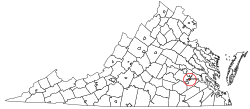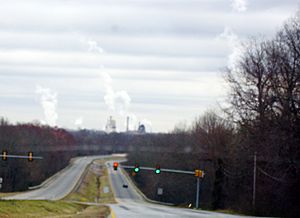Hopewell, Virginia facts for kids
Quick facts for kids
Hopewell, Virginia
|
|
|---|---|

Location in the State of Virginia
|
|
| Country | |
| State | |
| Incorporated | July 1, 1916 |
| Area | |
| • Independent city | 10.83 sq mi (28.05 km2) |
| • Land | 10.35 sq mi (26.82 km2) |
| • Water | 0.47 sq mi (1.23 km2) 4.9% |
| Elevation | 50 ft (15.2 m) |
| Population
(2020)
|
|
| • Independent city | 23,033 |
| • Density | 2,126.8/sq mi (821.14/km2) |
| • Metro | 1,314,434 |
| Time zone | UTC-5 (EST) |
| • Summer (DST) | UTC-4 (EDT) |
| ZIP code |
23860
|
| Area code(s) | 804 |
| FIPS code | 51-38424 |
| GNIS feature ID | 1495714 |
| Website | www.hopewellva.gov |
Hopewell is a special kind of city in the United States called an independent city. This means it's not part of a county. It's surrounded by Prince George County and the Appomattox River in Virginia. In 2020, about 23,033 people lived there.
Hopewell is part of the Tri-Cities area, which is near the larger Richmond area.
Contents
History of Hopewell
The Story of City Point
City Point is the oldest part of Hopewell. It was started in 1613 by Sir Thomas Dale. At first, it was called "Bermuda City," then "Charles City." This area was important because it was located where the James and Appomattox Rivers meet.
In 1619, representatives from Charles City attended the very first meeting of the House of Burgesses. This was an early form of government in the American colonies. Later, in 1703, the area south of the river, including City Point, became Prince George County.
During the American Civil War, General Ulysses S. Grant, a Union leader, made City Point his main base. This was during the Siege of Petersburg in 1864 and 1865. Even President Abraham Lincoln visited Grant's headquarters there.
The City Point Railroad, built in 1838, was very important during the war. It helped move supplies for the Union army. Today, it's part of the Norfolk Southern railway system.
City Point was a separate town until Hopewell officially took it over in 1923. Hopewell/City Point is the second oldest place in the United States where English people have lived continuously. Only Hampton is older. Jamestown, another early settlement, is no longer inhabited.
How Hopewell Grew from a Farm
Hopewell was once part of a large farm. In 1914, the DuPont Company bought this land and called it Hopewell Farm. DuPont first built a factory to make dynamite there. Then, during World War I, they started making guncotton, which is used in explosives.
Hopewell grew incredibly fast! It went from a small village of 400 people in 1916 to over 20,000 people in just a few months. Because of this rapid growth, it became known as the "Wonder City." Hopewell became an independent city in 1916.
After World War I, DuPont moved its factories. Hopewell became very quiet for a while. But in 1923, the Tubize Corporation opened a new plant. This helped the city grow again. Other big companies like Firestone Tire and Rubber Company, Allied Chemical and Dye Corporation, and Hercules Chemical also opened factories.
People of Hopewell in the 20th Century
Hopewell has always been a city of people who moved there to work hard. Many immigrants came from places like Bohemia (now part of the Czech Republic), Italy, and Greece. They worked in the factories and started their own small businesses. People also moved to Hopewell from other parts of Virginia and nearby states like North Carolina and West Virginia.
Like many cities in the South, Hopewell had Jim Crow laws that separated people by race. For example, at the Beacon Theatre in town, Black people were only allowed to sit in the balcony. In 1963, Hopewell's public schools began to desegregate, meaning students of all races could attend together.
Changes and Growth in Hopewell
In the 1960s, Hopewell tried to make its downtown area better. However, many shops moved to new shopping centers outside the city. For a long time, the downtown area was mostly empty.
But now, Hopewell is changing again! Many empty shops are being fixed up and new businesses are opening. The city spent a lot of money to build a beautiful new library, the Maude Langhorne Nelson Library. It has a cyber cafe and a cool replica of an old ship called the Hopewell.
The city also restored the historic Beacon Theatre, which was built in 1928. Now, it hosts many concerts and events every year with famous performers. New plants and street improvements are also making the city more attractive.
Environmental Efforts and the James River
Hopewell is located where the Appomattox and James rivers meet. The James River faced serious water pollution problems in the past. From 1966 to 1975, a chemical called Kepone was made in Hopewell. This chemical caused health problems for factory workers. It also polluted the James River, leading to a ban on fishing for many years.
After the Kepone issue was discovered in 1975, efforts were made to clean up the river. The fishing ban was lifted after 13 years. In 2019, Hopewell opened a "Riverwalk" boardwalk. This allows people to enjoy the scenic views and access the water, helping with the city's economic growth. Today, people can fish for bass and catfish at a Hopewell marina.
Hopewell is still home to several large chemical plants, including those owned by Honeywell Corporation, Ashland, and Evonik Industries. There is also a Green Plains Inc. ethanol plant and a paper mill owned by WestRock.
Recent Events in Hopewell
The Federal Correctional Complex, Petersburg (FCC Petersburg), which includes two federal prisons, is located just outside Hopewell in Prince George County.
In 2010, there were explosions at a new ethanol plant in Hopewell. The plant was not fully working yet, and no one was hurt. The plant has had some challenges but is now owned and operated by Green Plains Inc.
Hopewell has also been in the news because of how it handles speeding tickets on a short stretch of Interstate 295. Some drivers have called it a "speed trap." The city says it's about safety, as this part of the highway is important for Hopewell.
Hopewell has worked hard to improve its neighborhoods and housing. Many older homes, including Sears Catalog Homes and Aladdin Kit Homes, were built quickly during World War I for factory workers. The city is now working to restore and redevelop its historic areas, like the City Point Historic District.
Geography
Hopewell covers about 10.8 square miles. Most of this is land (10.2 square miles), and a small part (0.5 square miles) is water, mainly rivers.
Climate in Hopewell
Hopewell has a humid subtropical climate. This means it has hot, humid summers and generally mild to cool winters.
Neighborhoods in Hopewell
- City Point – This area became part of Hopewell in 1923.
Nearby Areas
- Chesterfield County, Virginia - to the north
- Prince George County, Virginia - to the east, south, and west
- Charles City County, Virginia - to the northeast
Protected Natural Areas
- Part of the Petersburg National Battlefield Park is located here.
Population of Hopewell
Hopewell's population has changed over the years:
- 1920: 1,397
- 1930: 11,327
- 1940: 8,679
- 1950: 10,219
- 1960: 17,895
- 1970: 23,471
- 1980: 23,397
- 1990: 23,101
- 2000: 22,354
- 2010: 22,591
- 2020: 23,033
Education in Hopewell
Hopewell has its own public school system.
High School
- Hopewell High School
Middle School
- Carter G. Woodson Middle School
Elementary Schools
- Dupont Elementary School
- Harry E. James Elementary School
- Patrick Copeland Elementary School
All these schools are approved by the Virginia Board of Education.
Special Schools
- Appomattox Regional Governor's School for the Arts And Technology in Petersburg, VA. This school is for students entering 9th grade who pass an admissions process.
Libraries
The Appomattox Regional Library system serves the city of Hopewell.
Famous People from Hopewell
- Robert Bolling and Jane Rolfe, early colonists
- Nelson Barclift, a choreographer (someone who creates dance routines)
- Sam Bass, an artist
- Curtis W. Harris, a civil rights activist (someone who works for equal rights)
- Charles Hardaway Marks, a politician
- TreVeyon Henderson, an American football player
- Joey Peppersack, a Paralympic swimmer
- Monsanto Pope, an American football player
- Steven R. Taylor, a politician
- Rebecca Beach Smith, a judge
- Lamar Giles, an American author
- Darrell Taylor, an American football player
Media
The Hopewell News was a local newspaper that covered news, sports, and events in Hopewell and nearby areas for over 90 years. It stopped publishing in 2018.
Images for kids
See also
 In Spanish: Hopewell (Virginia) para niños
In Spanish: Hopewell (Virginia) para niños



